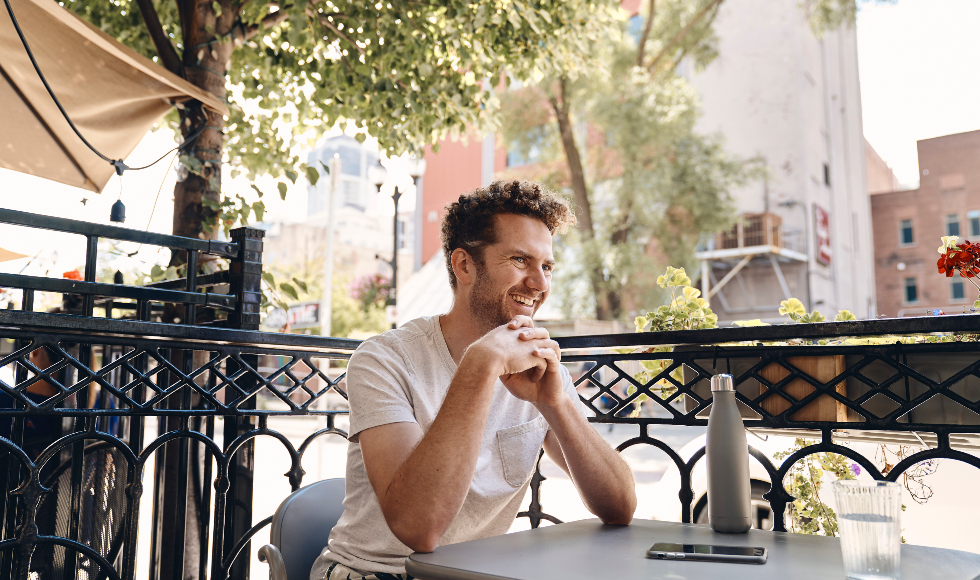Engineering Fresh Faces: Charles de Lannoy

Photo by Jin Lee
September 25, 2018
Welcome to Fresh Faces. In this series, we’re highlighting more than 40 Engineering faculty members hired within the last five years who are doing interesting and innovative things in the lab and the classroom.
Joining McMaster Engineering in 2017 as a Chemical Engineering Assistant Professor, Charles de Lannoy is focused on the environmental applications and implications of nanomaterials. In his Fresh Faces spotlight he talks about his love for Hamilton, striving to have a social justice impact with his research and the inspiring women in his life including his grandmother, one of the first female computer programmers in Canada.

On Hamilton
Hamilton is the Brooklyn of Toronto. It’s this city that once had a vibrant life in the 1910s and ’20s. It was a boomtown and then fell on really hard times from the ’80s until just recently.
But the character, that really blossoming architecture, and the vibe of the city is still there. It’s cool to be in a city in rapid transition. It’s a city that’s not looking to be entirely gentrified but is interested in developing with the community.

One of the major advantages of Hamilton is that it’s fairly affordable to live here. It’s full of artists and musicians who generally don’t make that much money but can still afford to pay rent, unlike living in Toronto. And if you want to pop into Toronto, it’s a 50-minute train ride away.
On three inspiring women
My grandmother, Alicia Sieciechowicz, was one of the first female computer programmers in Canada.
She fought in World War II as part of the Polish uprising against the Nazis. She was arrested and thrown into a concentration camp. After she was liberated, she fought for the allies in Italy. Then, she opted to go to England, met my grandfather, who was also Polish and had also fought in the war. They were both educated in England. My grandfather became an architect and my grandmother became an economist.

When they arrived in Canada in the ‘60s, my grandfather worked for the Government of Canada as an architect. Unfortunately, my grandmother couldn’t work as an economist because her English wasn’t very good so she decided, maybe to level the playing field, she would learn computer programming languages. So she learned an early version of Fortran and became a computer programmer, which, in those days, was primarily programming inventory. She did retail inventory for Eaton’s and then programmed student enrolment for the University of Toronto.
She was always really into science and got me interested in astronomy and astrophysics, and relativity, and is one of the reasons that I studied physics in university.
So she was a good programmer, and she’s a lifelong learner. She’s 95 and a couple of years ago she wanted to learn Spanish so she took an online Spanish course.
My mother was an academic and an anthropologist. She is inspiring because her research was motivated by her interactions with First Nations populations in Canada. She worked in many land claim cases defending First Nations populations and incorporated a social justice component to her academic research. So I’ve started to think about how I can have a social justice impact with my research endeavors.
My partner is an ultra marathon runner. She is a huge inspiration. She’s an incredible athlete, academic and lawyer.
On research with a social cause
One of my big projects is with Dawn Martin-Hill, associate professor in the Indigenous Studies Program at McMaster. Together, with a bunch of other professors, we have established an engineering and a social science program to study the impact of problems with water on First Nations communities. The goal is to understand how water problems are affecting communities and how engineers, like myself and others, can develop technologies to track how their water is evolving and to develop technologies to eventually treat that water. It’s a really nice merger of science, engineering and social science.

On working with students
I enjoy working with motivated students who are eager to explore new ideas and seeing them blossom into full scientists and engineers. Seeing them go from a student in the classroom to an experimentalist or a modeler, think about interesting problems in rational ways and develop innovative solutions that I wouldn’t even have thought of myself is really fun.
On one of the happiest moments of his life
When my mother was in remission from cancer my whole family went up to our family cottage, which was built by my grandfather in the ’60s. Family from Kingston, Vancouver and Toronto all gathered together to celebrate my mom and it was a very happy unification of the family.
Inside the lab…
I try not to get in the way of my grad students.
Outside the lab…
I try to think big picture when it comes to the environment. I try to think how best to support students in their research endeavors and in their education. And I try to remember to have fun while pursuing big engineering and scientific problems.


